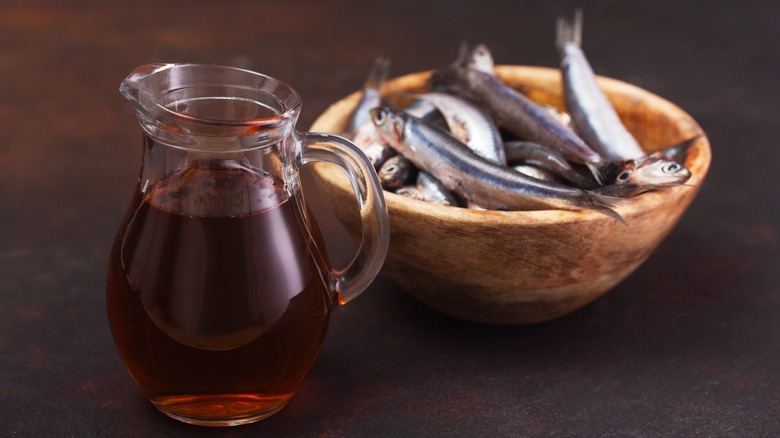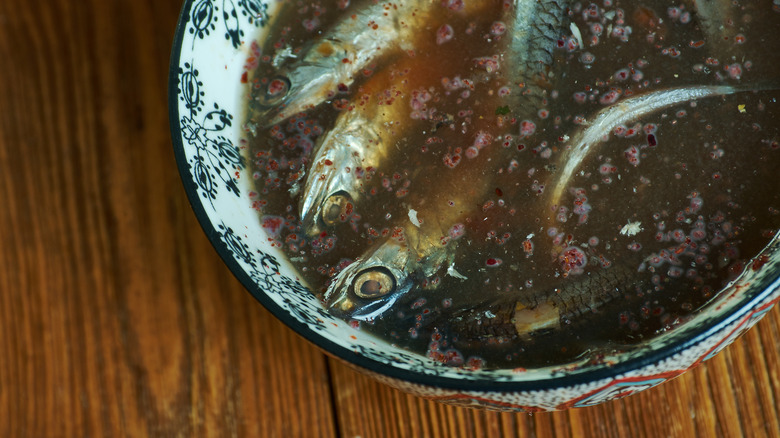The Pungent Fish Sauce Ancient Romans Ate With Everything
Umami — the so-called "fifth taste" — has become one of the hottest buzzwords in the culinary world, and for good reason. The deep, savory flavor becomes the foundation of every dish it appears in; sometimes subtle, sometimes strong, it has a way of enhancing all the other flavors in a dish. Certain ingredients are notable for their umami flavor, particularly fish sauce. Animal protein is rich in glutamate, the amino acid responsible for umami and the foundation of MSG. In fish sauce, the animal protein is fermented, further elevating the savory flavor. In modern cookery, fish sauce is often associated with Asian cuisines. Thousands of years ago, it was also all the rage in Ancient Rome.
The Roman version of fish sauce was called "garum," and it seems that they put it on just about every food imaginable. It was mainly used as a table condiment but could also serve as a base for other condiments and dressings and was even utilized as a folk medicine. While historians have long known about garum from ancient documents, the exact nature of its preparation and flavor appeared to be lost to history until quite recently. New archaeological discoveries have uncovered key details of garum's history, and it's finally making a return to our tables.
The ancient history of garum
The Ancient Romans did not conceive of garum themselves. They were preceded in the Eastern Mediterranean by the Ancient Greeks and Phoenicians. In fact, the name "garum" derives from "garos," the original Greek word for the fish species used to make it. Modern historians are unsure what fish garos referred to, as the sauce can theoretically be made from any variety of fish. In Roman times, it was typically made from scomber, which is commonly known today as the Atlantic chub mackerel.
Garum appears to have been extremely popular amongst the Ancient Romans. It is mentioned in the works of famous Roman writers like Martial, Manilius, and Pliny the Elder. The oldest known cookbook, "De Re Coquinaria," calls for garum as an ingredient in 350 different recipes. Many of these texts also refer to a fish sauce called "liquamen," which in the earliest writings appears to be different from garum; however, later texts seem to use liquamen and garum interchangeably.
Ancient recipes recovered from the Roman Empire reveal that salt was rarely used as an ingredient in cooking. As Andrew F. Smith notes in "Fish: Food from the Waters," they opted for garum or liquamen instead. There were various grades of garum produced in Rome, with the flavor ranging from mild to intensely pungent. Stronger grades of garum were more valuable and eaten by the wealthiest classes, while weaker versions of the sauce were used by home cooks and members of the army.
Recreating garum today
Garum all but died out with the fall of the Roman Empire, but it has reemerged as an object of fascination for chefs and food nerds. The garum-making process is detailed in several Ancient Roman texts, though often presented in less-than-appetizing language. Pliny the Elder called it "that secretion of putrefying matter" (via The Classical Journal). It's easy to see where he was coming from: Recipes from the era note that the fish should be fermented in vats exposed to the sun for up to three months.
Making garum is fairly simple — it's just fish and salt with spices/herbs added — but getting the fish-to-salt ratio right is crucial. The salt is needed to protect the mixture from harmful bacteria during fermentation. The process takes time — for fermentation to complete, plus multiple rounds of filtering to reach the final product.
Only recently have researchers begun to figure out what the garum of Ancient Roman times tasted like. In 2009, archaeologists uncovered vats of garum in the ruins of Pompeii. The condiment had been reduced to a powder according to Smithsonian Magazine, but food scientists were able to analyze it and determine that the sauce was made of anchovies and seasoned with mint, sage, and oregano. These herbs proved to be key, distinguishing garum from other fish sauces, but in case you don't want to spend three months stirring a vat of putrefying fish, Vietnamese extra virgin fish sauce is thought to be the closest approximation.


